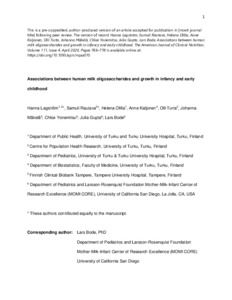Associations between human milk oligosaccharides and growth in infancy and early childhood
Anne Kaljonen; Johanna Mäkelä; Samuli Rautava; Hanna Lagström; Olli Turta; Chloe Yonemitsu; Helena Ollila; Lars Bode; Julia Gupta
https://urn.fi/URN:NBN:fi-fe2021042823220
Tiivistelmä
Background: Breastfeeding modulates infant growth and protects against the development of obesity. However, whether or not maternal variation in human milk components, such as human milk oligosaccharides (HMOs), is associated with programming of child growth remains unknown.
Objective: Our objective was to determine the association between maternal HMO composition and child growth during the first 5 y of life. In addition, the association between maternal prepregnancy BMI and HMO composition was assessed.
Methods: Human milk samples from 802 mothers were obtained from a prospective population-based birth cohort study, Steps to healthy development of Children (STEPS), conducted in Turku, Finland. HMO composition in these milk samples was analyzed by HPLC. Child growth data from 3 mo to 5 y were collected from municipal well-baby clinics and linked to maternal HMO composition data to test for associations.Results: Maternal HMO composition 3 mo after delivery was associated with height and weight during the first 5 y of life in children of secretor mothers. Specifically, HMO diversity and the concentration of lacto-N-neo-tetraose (LNnT) were inversely associated and that of 2'-fucosyllactose (2'FL) was directly associated with child height and weight z scores in a model adjusted for maternal prepregnancy BMI, mode of delivery, birthweight z score, sex, and time. Maternal prepregnancy BMI was associated with HMO composition.
Conclusions: The association between maternal HMO composition and childhood growth may imply a causal relation, which warrants additional testing in preclinical and clinical studies, especially since 2'FL and LNnT are among the HMOs now being added to infant formula. Furthermore, altered HMO composition may mediate the impact of maternal prepregnancy BMI on childhood obesity, which warrants further investigation to establish the cause-and-effect relation.
Kokoelmat
- Rinnakkaistallenteet [19250]
